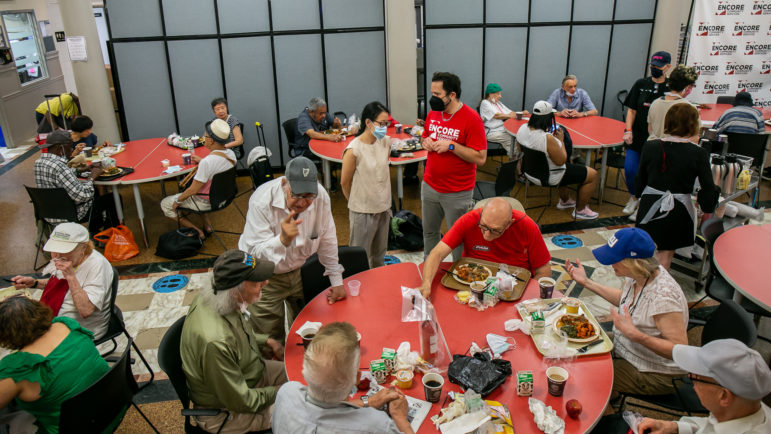Motherless Brooklyn … Fortress Brooklyn … Last Exit to Brooklyn … Only the Dead Know Brooklyn … A Tree Grows in Brooklyn.
Brooklyn is the imagined borough. It mutates for each observer. Its mythology is different for everyone, its neighborhoods vary depending on what side of the real estate divide you reside. Yet, at the same time, the borough remains doggedly, determinedly itself, despite its many changes.
“Dreamland Pavilion: Brooklyn and Development,” a conference on October 3rd at Kingsborough Community College, and a related art exhibit on the campus, “The Soul is the Size of Elsewhere,” are attempts to capture this inchoate reality.
Eben Wood, an assistant professor of English at Kingsborough and one of the prime movers behind the conference and exhibition, suggests that the concept of development is more complex than we generally admit—particularly when seen against the borough’s diverse cityscape of 2.5 million people. “The word ‘development’ at the same time represents actual changes in the borough and is supposed to express the meaning of those changes,” he says.
One of the works in the art exhibit—a close examination of the redevelopment of Fulton Mall—offers a fine illustration of his point: Over the past five decades, what had been the Albee Square Theatre (an ornate movie palace) became a mall and then a vacant lot. Not exactly the narrative of progress the word “development” seems to imply. And it’s not at all clear that the Manhattan-style office and residential tower that’s been proposed for the site will be a benefit for the borough either.
The exhibition aims at creating a documentary portrait of the rapidly changing fabric of Brooklyn. Shards of steel scavenged from the Ward Bakery—a building demolished to make way for the Atlantic Yards project—cascade across several pedestals. Portraits of downtown, Atlantic Terminal, Fort Greene and the Gowanus Canal vie for attention on the walls. But the fact that the exhibition is at Kings County’s community college—an institution with more than 20,000 students who hail from more than 100 different countries—might have reminded the curators to try for a broader reach. The borough’s black, Latino, and white working class realities, plus the energizing influx of new immigrants, are largely missing here, though they are equally relevant markers of Brooklyn’s changing soul as the middle class areas that are featured.
The 20 sessions of the conference will make no such omission. They view development through a wider-angle lens than the artists seem to. For instance, in one session, Brian Purnell, an assistant professor of African and African-American Studies at Fordham University, will offer verbal snapshots of several forgotten chapters of race relations in the borough, such as the NAACP’s unsuccessful effort to desegregate Brooklyn’s schools in the early and mid-1950s. He will also examine police violence against African-Americans through the stories of George Waddell and Herman Newton, young Brooklyn men who were killed by NYPD officers in 1949. Local NAACP members wanted to mount a major campaign for accountability in the police department. But the NAACP’s national office, which felt that the Brooklyn struggle would detract from the fight against lynching that was being waged in the South, pressed local activists to abandon the cause.
In another workshop, Wendy Galgan, a poet and English lecturer at St. Francis College, will explore the impact of Brooklyn’s street eloquence on local poets. It emerged, of course, in protean form in Walt Whitman’s work. But the changing speech patterns of the borough impacted a large number of poets, including June Jordan, whose 1975 work “For Michael Angelo Thompson” is a passionate lyrical scream inspired by the true 1973 story of a black Brooklyn teen who was hit by a bus, turned away by a local hospital and later died from his injuries.
Norman Oder, whose blog on the Atlantic Yards development has been a key resource for information and analysis of that real estate deal, will present his view of the PR war over the project. City Limits’ former editor, Alyssa Katz, will share insights from her new book, “Our Lot: How Real Estate Came to Own Us.” Other speakers will focus on Brooklyn’s labor struggles, the lives of Caribbean child care workers, child-rearing and education in the Russian community, and the gastronomic pretensions of some borough neighborhoods, among dozens of other topics.
Back at the gallery, one work seems particularly apt. It’s a short looping video (only a few seconds, really) of an oil bubble developing and erupting onto the snot-green surface of the Gowanus Canal. That bubble—coalescing, oscillating, bursting and dissolving for eternity in its filmic life—is a disconcerting reality. Yet it is also oddly compelling. You might even call it beautiful. That’s Brooklyn for you.
‘Dreamland Pavilion’ will be held in the Rotunda of the Marine and Academic Center building at Kingsborough Community College (2001 Oriental Boulevard in Manhattan Beach) on Saturday, Oct. 3rd. Admission is $25 ($30 at the door; discounts available for students; and organizers insist, no one will be turned away for lack of funds.) ‘The Soul is the Size of Elsewhere’ can be seen in the gallery on the ground floor of the nearby Arts and Sciences Building.








